"Don’t toss a coin, know both sides before you decide"
Grass and measurement
It is a time tested and proven fact that grass is the cheapest and most nutritious feed you have, and you need to get in as much good quality grass as possible into your cow.
And you already know that measuring (putting a number to the amount of available grass in your paddock) and budgeting (making grazing decisions and managing targets each week on the amount of grass on your paddock) grass always holds the key to reduce costs and make your profits in volatile markets.
But, despite constantly measuring and budgeting grass, you end up not hitting your targets.
Does this happen to you every time, some times or even occasionally?
Operational management on a farm has multiple and conflicting demands.
- Firstly, events that are beyond your control and are unpredictable can spoil your grazing plans. For example, weather changes, like much rain. Waterlogged pastures, lessen grazing time.
- Secondly, for calculation purposes, you will need accurate data from every paddock (pre and post grazing pasture mass and leaf stage monitoring) to help decision making. This data collection is time-consuming, labour-intensive and expensive.
The hurdles are many.
Are you perplexed with sub-optimal grazing decisions?
Can grazing management ever be perfected?
You deserve to know the truth, and I would like to provide you with help with this decision making of achieving your optimal grazing level through grass measurement and get to your profits.
The need for an effective grass measuring tool
High quality and green, leafy grass can be maintained in your paddocks by walking the pasture every week and measuring grass. There are many ways to measure your grass.
Oh yes, the options are one too many.
It is but natural for you, as as a farmer to straightway opt for methods that come to you as cheap, easy in design or portable, such as Eyeballing/ Visual estimate method and the Quadrant Cut method.
But the question here is:
“Are inexpensive, simple and easy-to-carry, all that it takes to making effective grazing decisions and earning those profits from your pasture?”
You will know the answer at once after you read this article.
I have previously explained the disadvantages of the Eyeballing technique.
Let us now examine the pros and cons of using the Quadrant Cut method for measuring grass to help you decide the optimal feeding levels that you deserve.
The Quadrant Cut and Weigh method explained
What is the quadrant?
Any frame (usually a square, but can also be rectangular or circular) that is used to define a sample of pasture, irrespective of its shape, is referred to as a quadrat (or quadrant).
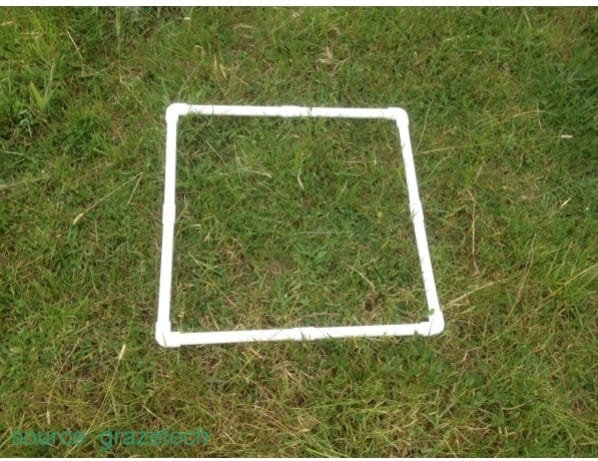
The Process:
The process of measuring grass using the quadrant cut method (also known as the cut and weigh method) involves cutting grass found within the quadrant, weight them and applying mathematical formulae to estimate the grass yield in kg DM/ha. The below steps explain how it is done.
- Randomly place three to ten quadrants across all your paddocks. The more quadrants you use, the more accurate will be your result. The quadrat can be between 0.1 sq. m to 1.0 sq.m in area.
- Trim the grass that falls within the quadrat to ground level, cut back to between 3.5 and 4cm; The grass within each quadrat is called the sample, the representative of the total amount of grass in your pasture.
- Harvest this sample grass (what’s inside of the quadrat) to ground level (cut between 3.5 and 4cm height) and place in a bag for weighing. (sample 1, sample 2, sample 3)
- Make a record of the fresh weight of each sample (weight 1)
- Dry the three sample grass (drying at 80 degrees centigrade for 20 hours Or placing in a microwave for 1 minute) and record the dry weight of each sample (weight 2)
Useful tips:
Tip (1) - While choosing a representative area, make sure that the areas you plan to assess represent your entire pasture. This can be achieved by walking along an imaginary transect line (diagonally or randomly- as shown in the figure below)
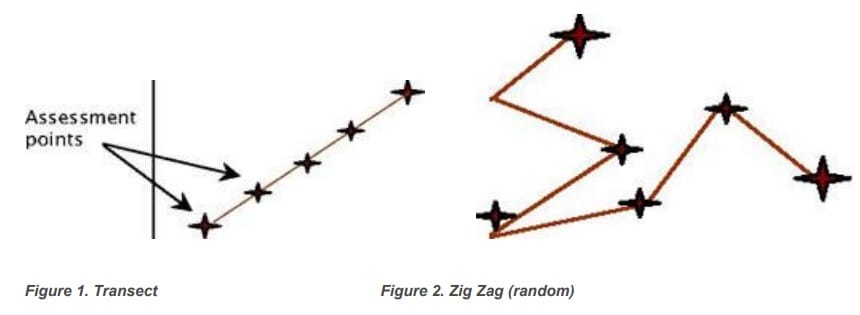
Tip (2) - If you are convinced the area is uniform, 8 to 10 assessments will suffice, but if there is a high variability you should take at least 15 assessments or more, based on your paddock area.
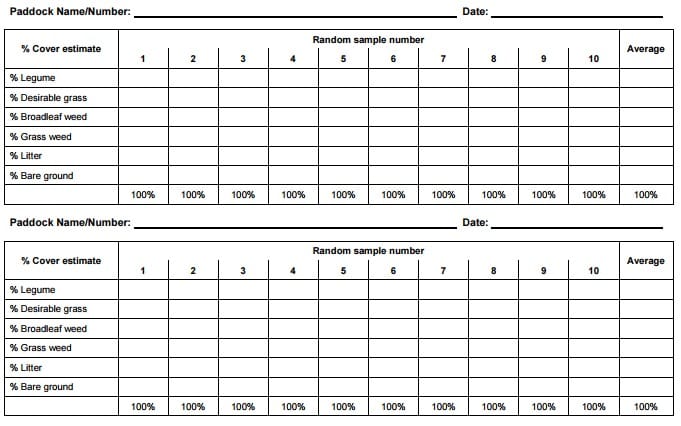
Tip (3) - While cutting grass, do use a sharp hand-held shearing instrument; do not use lawn trimmers, as they make wrong placement while cutting and give error results.
Tip (4) - DM represents the average dry matter content as a percentage of the total feed weight. This is important because moisture content doesn’t translate into nutrition. So DM values give you more accurate nutritional intake values.
The Deployment:
It’s always all about numbers! You have cut the grass and measured them.
What do you do thereon?
How will I know my yields?
How will I budget my grass?
Let’s get to some number-crunching.
First, get the average weight of the three samples and take an average of them.
Avg. weight= (weight 1 of sample 1 + weight 1 of sample 2 + weight 1 of sample 3) / 3
Next, to get the DM yield to multiply the average weight per quadrant into the dry matter percentage into the number of quadrants per hectare.
DM Yield or Kg DM/ha in the paddock = Weight of grass (kg) x DM% x 40,000 (40,000 quadrant sized pieces make up a hectare)
For example, if your average quadrant grass weight is 0.25 kg with 20% DM content – Your available Grass Cover will be 0.25 kg x 0.20 x 40,000 = 2,000 kg DM/ha.
Here are some broad statistics on the Cut Grass DM content.
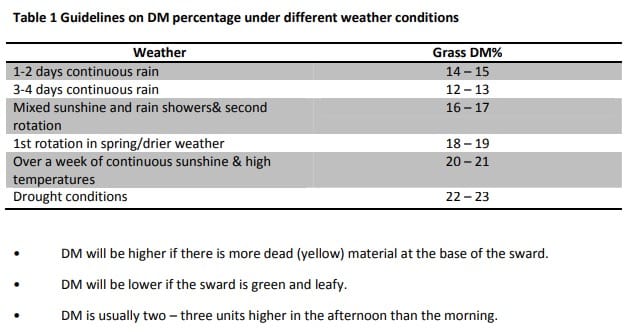
Calculating your entire pasture’s Grass Cover; across all your paddocks.
- Measure the quantity of grass in each paddock i.e.: the DM Yield (=1,600 kg DM/ha, considering the above example).
- Multiply the DM yield of each paddock by the area of the paddock in ha 1,600 x 1.6 ha = 2,560 kg DM. This gives you the grass cover available in the whole paddock.
- Similarly, calculate the DM yields for all the paddocks on your pasture.
- Sum up all the paddock-wise DM yields
- Calculate the sum total of all your paddock areas (grazing lands), in hectares
- Calculate your pasture’s total grass cover, your Grass Wedge, using this formula:
Grass wedge = Sum total of all your paddock-wise DM yields (value 1) / Total area in ha
However, this only gives your pasture availability. It cannot help you put together a grass wedge visual (refer below image) to help you create effective rotational plans.
I know. The Quadrant Cut method of measuring grass sounds like a lot of work. Especially, when you have to do this for more than 200 hectares, every week.
But, is it worth it?
To answer that, let’s consider the advantages and disadvantages of deploying the quadrant cut method.

Advantages of the Quadrant Cut method
Quadrants are:
- very precise, and so mainly used for research
- easy to make, you can do it yourself
- easy to use, no user training required since only very few decisions are required to be made by the observer
- easy to carry, there is just a quadrat and clipping sheers aside of paper and pencil
- inexpensive
- suitable for measuring grass, since plants are stationary, inactive species and you won’t have to bother with a counting unit
- able to mitigate risks of cloud cover impact on satellite images
Disadvantages of the Quadrant Cut method
On the other hand, quadrants also:
- require on-site presence to perform the work in the field.
- are time-consuming/ slow and expensive for large pastures (The average-sized New Zealand dairy farm and sheep farm are 172.2 ha and 443 ha respectively).
- are not suitable for uneven populations of grass. Grass covers keep changing with the seasons and weather, sizes can vary as they grow and therefore frequent measurements are required over long sampling windows.
- are prone to errors- quadrants can be too large or too small or spaced inappropriately. The grass quality (dry or dead grass has low feed value) are not taken into account while measuring.
- can inadvertently destroy paddock grass during harvesting and wrong placement.
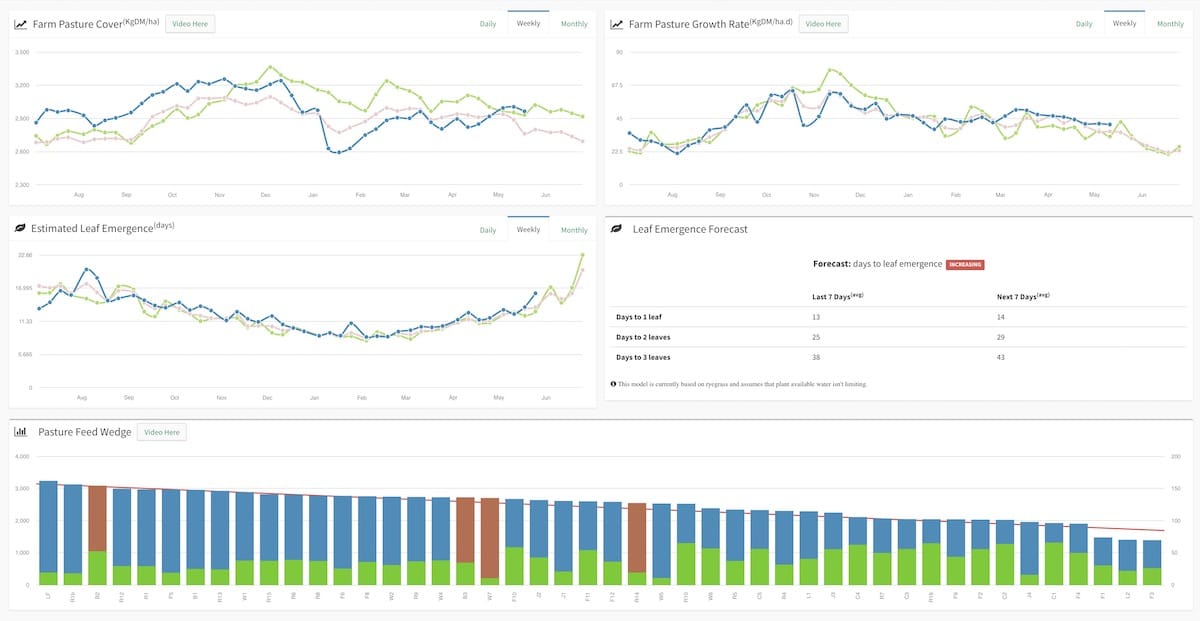
What next?
Measuring your pasture growth regularly can help you earn an additional 385 dollars per hectare per year. So however you do this, it is going to be worth your time, effort and money. That said there are more time and cost-effective ways of measuring pasture growth.
A quadrant cut method is probably more suitable for research or for small areas of land. If you’re a commercial livestock farmer you might need another method to measure your pasture, to ring in those additional profits. If you’re interested to learn more about earning additional profits from your pasture, consider downloading this free e-book now.
The team at Pasture.io is always around, to help you put your pasture growth measurements on auto-pilot.
Until we meet again, Happy Farming!
- The Dedicated Team of Pasture.io, 2020-09-17